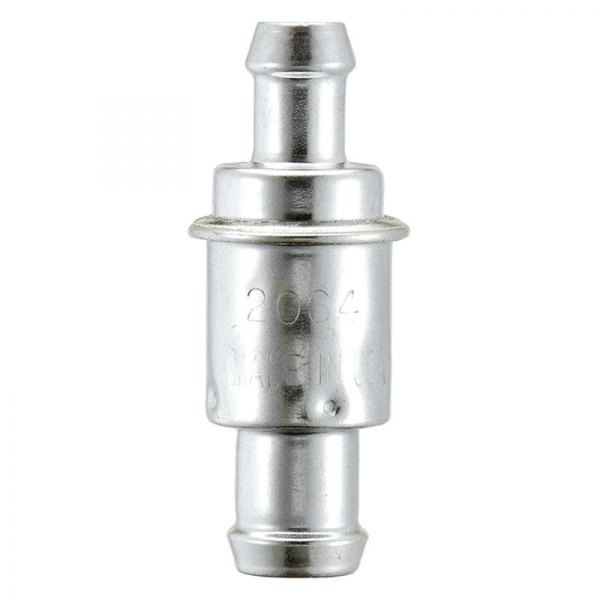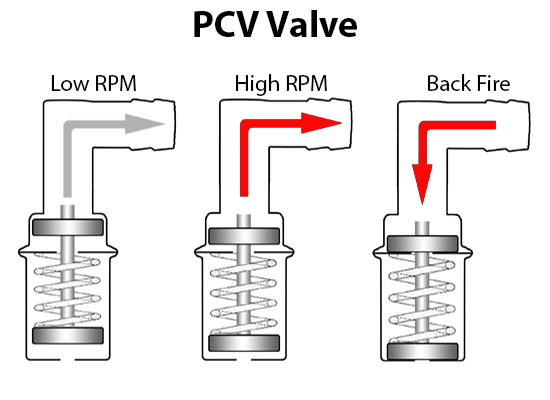

|
|||||||
| PV, 120 (Amazon), 1800 General Forum for the Volvo PV, 120 and 1800 cars |
 Information
Information
|
|
Crankcase ventilation and brake servo vacuumViews : 1835 Replies : 28Users Viewing This Thread : |
 |
|
|
Thread Tools | Display Modes |
|
|
#21 |
|
VOC Member
Last Online: Yesterday 17:06
Join Date: Jul 2006
Location: Chatham
|
PCV has different size ends. 5/16" and 3/8" I think. Small size down. Correct hose size will allow you fit it without clamps. Valve should be vertical above the side ear so keep the hose length to the ear as short as possible without allowing metal to metal contact. Not critical, just keep the hose short.
The internal valve has a light spring to assist the movement. Keeping it vertical allows the shuttle to move freely up and down. The engine is basically a pump. When these closed circuit types of systems are working properly the engine should be under a slight vacuum at all times to keep the oil and fumes inside. If the system blocks up or is wrongly configured the engine is then pressurised, which forces oil out of any weak spot. Often this is front and rear crank seals. The PCV shouldn't rattle if you shake it but should respond easily to a suck or blow. |
|
|

|
|
|
#22 |
|
Junior Member
Last Online: Mar 28th, 2024 16:36
Join Date: Aug 2018
Location: Surrey
|
Hi Ron,
I agree that there is no flow to or from the brake servo unit - the volume just needs to be evacuated. I agree that the flow from the crankcase is (virtually) unidirectional. If I put the pipe from the PCV valve in my mouth I can very easily suck air. If I try to blow down the same pipe I can just about push some air into the crankcase, but it's a struggle (and I used to play cornet in a brass band!). I'm not getting any orifice-limiting in this line though. The PCV valve certainly doesn't feel as though it is restricting the flow. Sucking on that pipe isn't quite as easy as breathing through a snorkel, but almost. The valve itself is brand-new - should it be restricting the flow more than this? The Volvo Technical Bulletin that Burdekin found says that the restriction should be in the nipple that connects the PCV pipe to the inlet manifold. I'll check later to see whether the nipple on my manifold is restricted or not, but I expect that it is. The problem is that my manifold only has one tapping for one nipple, so I'm using a Y-piece to connect both PCV-line and brake servo-line in to one restricted nipple. The manifold is sucking air through a 2mm hole in the nipple, but unrestriced air is coming down a 10mm pipe from the PCV to my Y-piece. Small flow of air out, unrestricted flow of air in, result: the brake booster doesn't get evacuated. Two possibilities spring to mind: 1) Is my new PCV valve faulty? Should it be restricting the flow of air from the crankcase to my Y-piece? 2) If not then I surely need to remove the orifice restriction from the nipple (drill it out) and put a 2mm restriction between my Y-piece and the PCV. |
|
|

|
|
|
#23 | |
|
Junior Member
Last Online: Mar 28th, 2024 16:36
Join Date: Aug 2018
Location: Surrey
|
Quote:
My PCV valve does rattle when I shake it though - is that a seriously bad sign? |
|
|
|

|
|
|
#24 |
|
Junior Member
Last Online: Mar 28th, 2024 16:36
Join Date: Aug 2018
Location: Surrey
|
I had a bit of spare time this morning so I went into work to use the workshop.
The first thing I made is a new nipple to fit on the manifold. The original is restricted down to a 2mm hole but my new one has a 7mm hole all the way through. Now I've got "unrestricted" vacuum as far as my Y-piece. Then I made a 2mm restrictor/connector that I've fitted between the Y-piece and the PCV valve. That way the flow of fumes from the crankcase is limited. I put it all together and all seems well. The brake servo is working as it should and I must be getting some positive crankcase ventilation. Now I want to see if that stops the occasional drip of oil from the underside of the oil filler-cap onto the rocker cover. The last job on my list is to confirm that I've got the PCV valve fitted the right way round. Logic is telling me I've got it right - easy to suck fumes out of the crankcase, very difficult to blow back the other way. However, that means I've got the smaller spigot on the valve pointing up when Derek said it should be down. But for now the car is running, the brakes are working, the sun is shining so we're heading out for a walk somewhere! |
|
|

|
|
|
#25 |
|
Master Member
Last Online: Yesterday 15:52
Join Date: Jul 2020
Location: Saskatchewan, Canada
|
In the PCV valve, at low RPM the vacuum in the manifold 'sucks' a piston up until it is not quite closed (complete closure is limited by springs in the PCV valve). The movement of the piston creates a reduced opening limiting flow through the valve. At high RPM the vacuum in the manifold is reduced allowing the piston to drop increasing the opening size and allowing for continued flow through the valve at the reduced manifold vacuum. The following provides a simple treatise on the operation of the valve.
https://help.summitracing.com/app/an...cv-valve-do%3F My first observation is that if the original manifold nipple was restricted to 2 mm that would be meant for a B20 which does not use a PCV valve and definitely would not provide sufficient vacuum in the Tee tap for operation of the brake servo. The correct 7 mm orifice for the B18 should provide sufficient vacuum for the operation of the brake servo (you seem to have confirmed this). If the PCV valve is working correctly at idle it should be moving into the restricted position reducing air flow through the valve which should maintain the vacuum on the line to the servo. It seems like your PCV valve was not doing this at idle / low speed operation. If you are up for a test, remove your 2 mm orifice and reconnect your PCV system. With the engine running at idle pull the PCV valve off the oil separator and check the vacuum on the bottom of the valve (valve inlet). Now pull the valve out of the hose and check the vacuum on the hose going up to the bottom of the Tee (this should be manifold vacuum). The vacuum at the inlet to the PCV valve should be much less than the manifold vacuum because the PCV valve would normally be restricting flow under idle condition. If the vacuum at the bottom of the valve is not significantly less than the manifold vacuum the PCV valve is installed backward (unlikely since I think this should stop all airflow because of the back fire feature), the PCV valve is incorrect or is defective. A correctly functioning PCV valve performs the same function as the restricting orifice. Theoretically if the PCV spring and orifice sizing is done correctly its better than a fixed 2mm orifice because it is variable and responds to different conditions in the manifold. However, that is a 'theoretical' and presumes that the current replacements for the B18 PCV valve are exact as opposed to a valve that happens to fit. If you can't get the PCV valve to function correctly and your 2 mm restrictor in the line to the oil trap seems to be doing the trick you might want to consider just removing the PCV valve altogether. Last edited by 142 Guy; Nov 22nd, 2020 at 18:42. |
|
|

|
|
|
#26 |
|
VOC Member
Last Online: Yesterday 17:06
Join Date: Jul 2006
Location: Chatham
|
Rattle as in every things loose inside. The spring should dampen things down. In the USA these are like $6. No reason why they should be expensive here in the UK. The genuine AC Delco ones are a bit more expensive but still cheap over there.
|
|
|

|
|
|
#27 |
|
Junior Member
Last Online: Mar 28th, 2024 16:36
Join Date: Aug 2018
Location: Surrey
|
Thanks Derek and 142 Guy,
The PCV valve I've got looks like this:  (This photo is on the Fram website so may not be the exact model/part number. I bought mine from Brookhouse so it should be right for Amazons) I've fitted it as orientated in the photo - small hose-fitting uppermost. Just looking at the Summit site that seems to be correct in that the overall shape of the valve is the same in both cases:  It does rattle when I shake it - not unlike a rattle-can of spray-paint. If I try to blow down the smaller end I meet a lot of resistance though I can still push some air through. I take it that this is in "back-fire" mode. I'm sure a proper back-fire has a lot more pressure than me blowing, so may shut the valve even tighter. If I suck on the small end I can pull air through the valve fairly easily. Maybe this mimics the high rpm situation when the manifold vacuum is low? I can't suck hard enough to get the valve to restrict flow in this direction but perhaps the engine can at idle? I think my next test will be to take my restrictor out of the PCV line and see if the brake servo still works. That should show whether the PCV valve is acting like a restrictor at low revs. I'll report back! |
|
|

|
|
|
#28 |
|
Junior Member
Last Online: Mar 28th, 2024 16:36
Join Date: Aug 2018
Location: Surrey
|
I took the restrictor out of the line between the PCV valve and the Y-piece. The engine runs and the brake servo works well. I had it almost-right on Friday; I just needed an unrestricted nipple on the manifold.
Many thanks to everyone for their insight and advice! |
|
|

|
 |
| Currently Active Users Viewing This Thread: 1 (0 members and 1 guests) | |
|
|